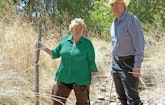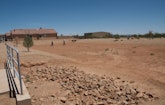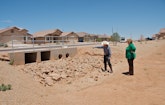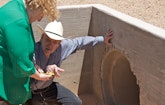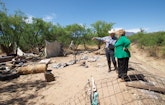
Interested in Inspection?
Get Inspection articles, news and videos right in your inbox! Sign up now.
Inspection + Get AlertsPhase II of the Clean Water Act hit the small rural community of Sierra Vista, Ariz., squarely be-tween the eyes. With no state or federal money to fund the stormwater management mandate, the city council told the Department of Community Development to figure out how to achieve compliance.
James Herrewig, director of Community Development, and Jenifer Thornton, management analyst, volunteered. “It was a huge learning curve because we aren’t engineers, and we have to do everything as inexpensively as possible,” Thornton says. “It came down to incorporating stormwater into our jobs.”
The MS4 program approved by the council left Herrewig and Thornton struggling to comply with regulations geared not for desert washes or arroyos, but for major cities with storm sewers. Experience told them that with eight inches of annual rainfall, residents would never accept a stormwater fee. To persuade them and contractors to accept an ordinance diehards viewed as ludicrous, the pair focused on education delivered with a soft touch — and succeeded.
Today, Community Development still has no separate stormwater line item in its $400,000 operations and maintenance budget, but the accomplishments of Herrewig and Thornton have attracted the attention of other small MS4 communities, asking how they did it with little or no money.
Capture and filter
Sierra Vista, 75 miles southeast of Tucson, lies at the base of the Huachuca Mountains to the west. The Mule and Dragoon Mountains are to the east. The San Pedro River runs through the valley and mainly underground.
The river, originating in Cananea, Mexico, flows south to north, supporting an important riparian habitat in the Upper San Pedro Watershed. During the monsoon season from mid-June through mid-September, stormwater drains off the land in sheets and into centuries-old natural washes flowing west to east. The water never reaches the river, 10 miles outside the city limits.
The monsoons provide the only opportunity for the city to recharge its aquifer. Vegetation is allowed to grow in the washes to slow the flow; Public Works crews cut it once after the rains. From then on, the washes are dry.
Scientific studies revealed that the soil in washes increased absorption rates, so the city, the U.S. Army Corps of Engineers, and U.S. Army Fort Huachuca built retention ponds in them. Additional studies showed that detention basins captured and filtered runoff better.
Beginning in 2003, the ponds were replaced with basins: four large ones on the west side of the city where it abuts the Army base, and four built by the Corps of Engineers inside the base. The city owns six large detention basins within its 20 square miles. Subdivisions and commercial developments have a multitude of smaller basins.
Building detention basins involves scooping out a depression in the wash, then constructing a check dam with a culvert downstream. During rainstorms, the culvert releases water more slowly than it comes in, causing the basin to fill as the deluge progresses. Alan Humphrey, senior civil engineer, balances release time with basin size and expense to design the most efficient regional facilities.
Walk the line
While the city welcomes the monsoons, they mean increased paperwork for Herrewig and Thornton as they double-check that contractors have prepared their sites to prevent the rains from washing away soil. Some storms, however, dump copious amounts of water in minutes, then stop. “No matter how contractors plan, they can’t keep the soil on-site,” says Thornton. “It just pours off, making even more paperwork.”
Smaller, long-time contractors laughed when the pair told them that mud could no longer fall off their trucks as they left construction sites. “They couldn’t see the logic of the mandate when that mud ran into muddy washes,” says Herrewig.
The Southeastern Arizona Contractors Association (SACA) rode to the rescue, supporting the MS4 ordinance and telling the few resistant companies that they must comply. Thornton worked with the association to establish a training curriculum for installing silt fences, straw bale barriers, and other Best Management Practices. She hired Jay Knoll of the Environmental Planning Advisory Committee (EPAC) in Green Valley and Tracy Castell, president of Sonoran Enviro Tech in Tucson, to teach it.
“We held four basic education classes and one on advanced stormwater management,” says Thornton. “The city provided $15,000 and the classroom. SACA advertised the courses and filled the seats. We were fortunate that both entities believe in education and working with the contractors rather than alienating them through strong-armed tactics and fines.”
Most contractors sympathized with Thornton and Herrewig, realizing that they were learning on a job nobody wanted. John Eyre, P.E., of the state Department of Environmental Quality, taught them how to inspect sites and answered questions. Eyre and Knoll worked with the only resistant contractor without penalizing him.
“It’s remarkable how contractors assist each other to avoid infractions,” says Thornton. “They’ll drive past a site, see something wrong, and call each other or us. We evaluate the situation, then alert the contractor and work with them to fix the problem. Our enforcement is education and our results are positive.”
Available resources
The city’s education program included creating stormwater pollution prevention fact sheets for residents and contractors. Rather than reinvent the wheel, staff searched southwestern city and agency websites for information, focusing on Texas, New Mexico, Arizona, and southern California because their climates are similar and they have no underground stormwater infrastructure.
Following Best Management Practices, fact sheets for residents provided ways to keep home and yard pollution from reaching the washes. Since the city has no industry, the staff wrote fact sheets for carpet cleaners, auto mechanics, restaurant owners, and construction companies, focusing on the use of BMPs and MS4 reporting requirements.
The effort is paying off. For the most part, carpet cleaners no longer pour dirty water on streets, and pest-control contractors no longer dump leftover pesticides in washes. Nevertheless, the washes and state trust land within the city limits remain wildcat dumpsites for garbage and household goods. The practice is a problem because sheet flow drainage carries the trash directly to the washes and pollutes the water.
“When we find illegal trash, we cut open the bags and search for names,” says Herrewig. “Then we work with police to track down the perpetrators and make them clean it up.” In one instance, Herrewig was in his snake boots walking down a wash in response to an illegal dump call when he smelled something awful. “I was praying that it wasn’t human remains,” he says. “The source was a fully loaded refrigerator. Public Works had to pull it out with heavy equipment.”
The city established a hotline to report violations anonymously. It also created an Adopt-A-Wash program. “Activities like picking up trash and monitoring a small segment help volunteers develop stewardship and empower them to make a difference,” says Thornton.
Clean water, please
Stewardship even extends to backyards, the only area where the city water conservation code allows grass. Development codes require stormwater to flow from the rear of lots to the front, enter the streets, and discharge to the wash.
Lots along washes may drain into them. These properties often have brick walls at the rear. Homeowners occasionally remove a brick to release ponding water from monsoons, or run a pipe (illegally) through the wall to drain swimming pools.
Herrewig walks the 26.5 miles of washes looking for these discharge points and others. When he talks to homeowners with swimming pools and weep holes, most are receptive to his clean-water message.
“I don’t ask them to plug the hole because it relieves water pressure against the wall, but I do stress the importance of not allowing pesticides and fertilizer to enter the wash,” he says. “The owners often replace the brick or plant vegetation in that corner to slow the flow.”
Herrewig initially marked the discharge points on an aerial map as part of the stormwater mandate. Now he uses a handheld GPS unit. “Our goal for 2011 is to enter all locations into our Encompass GIS mapping system from Geodesy,” he says.
Herrewig and Thornton have tapped into the WaterWise program from the University of Arizona Cooperative Extension Cochise County for advice on using graywater, rainwater harvesting, rain gardens, water-efficient landscaping, and indoor and outdoor water conservation. Cochise County, Sierra Vista, and Fort Huachuca contribute money to the program.
State and county laws require graywater to remain on-site and not come in contact with the public. “It can’t even drain down the street,” says Thornton. “Those restrictions make it impossible for smaller lots to use it.”
Regulation strangulation
The challenges of the past six years have stretched Herrewig’s and Thornton’s imagination and resources, but the U.S. EPA mandate to test stormwater for turbidity in 2012 may be asking too much of a community with only natural washes.
“Compliance will be hard because our runoff has a lot of turbidity,” says Herrewig. “We can’t afford to set up our own laboratory, and sending out samples is expensive. However, we’ve always found ways to do things inexpensively in the past, and hopefully we’ll find a low-cost way to test the water.”
Meanwhile, the two continue to educate homeowners and contractors. “Taxation and enforcement will never work in rural Arizona,” says Thornton. “Education is the only route, and it is achieving the result anticipated for the program.”

